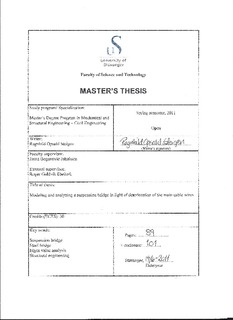| dc.description.abstract | Lysefjord Suspension Bridge, with a main span of 446 meters, has had problems with wire fractures in the main cables. This is reducing the durability of the bridge. Since the opening of the bridge in December 1997, over 1400 outer wire fractures have been detected. No clear reason for the failure has been found, but some material defects in the wires could be part of the reason. If the wires continue to fracture with the same rate as today, the main cables have to be maintained more often, and maybe changed much earlier than they were planned for in the beginning. Therefore, the bridge should be further analyzed, to detect any other reasons for the wire fractures, and to determine how and when the main cables should be maintained or changed.
A new finite element model is created in ABAQUS, and an eigen value analysis of the bridge model is carried out. A brief analysis of the fractures in light of the weather around the bridge is given. The main components of a suspension bridge are described, and analytical calculations are done based on equations from Bleich and Steinman to verify the results from ABAQUS and Alvsat. The bridge behavior during wind loading was briefly checked, and the displacement from wind load, from a 50 year wind speed, on the bridge has been examined. The loading from this wind speed, with coefficients that take into account different angles of the bridge girder, has been created in ABAQUS, through several iterations.
The eigenfrequency analysis done in ABAQUS and the analytical calculations give results that are in the same range as the ones from the original analysis done in Alvsat. The result from the analysis of the weather around the bridge in a period with many wire fractures indicates that after a sudden drop in temperature, many wire fractures occur. The critical wind velocity in regard to vortex induced vibrations is 7.5 m/s for the first vertical symmetric mode, this is a wind speed that can occur around the bridge, and fatigue in the wires could be a part of the reason for the cable fractures. The demand/capacity rate for the main cables with dead load is 25.2\%. The results from this work can be used when deciding what to emphasize in further analysis of Lysefjord Bridge. | en_US |
